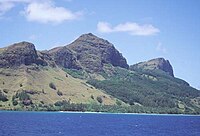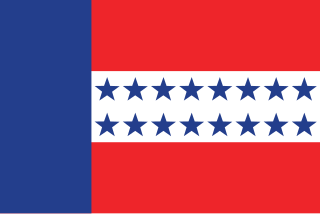
The Tuamotu Archipelago or the Tuamotu Islands are a French Polynesian chain of just under 80 islands and atolls in the southern Pacific Ocean. They constitute the largest chain of atolls in the world, extending over an area roughly the size of Western Europe. Their combined land area is 850 square kilometres. This archipelago's major islands are Anaa, Fakarava, Hao and Makemo.
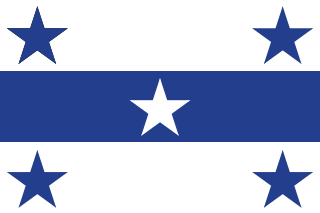
The Gambier Islands are an archipelago in French Polynesia, located at the southeast terminus of the Tuamotu archipelago. They cover an area of 27.8 km2 or 10.7 sq mi, and are made up of the Mangareva Islands, a group of high islands remnants of a caldera along with islets on the surrounding fringing reef, and the uninhabited Temoe atoll, which is located 45 km south-east of the Mangareva Islands. The Gambiers are generally considered a separate island group from Tuamotu both because their culture and language (Mangarevan) are much more closely related to those of the Marquesas Islands, and because, while the Tuamotus comprise several chains of coral atolls, the Mangareva Islands are of volcanic origin with central high islands.

Rikitea is a small town on Mangareva, which is part of the Gambier Islands in French Polynesia. A majority of the islanders live in Rikitea. The island was a protectorate of France in 1871 and was annexed in 1881.
Aukena is the 5th largest of the Gambier Islands in French Polynesia. Aukena is located about halfway between Mangareva and Akamaru, or about 5 km southeast of Mangareva, which is the largest island of the whole Gambier Islands archipelago. Aukena is approximately 2.5 km long and about 0.5 km wide, with a total area of 1.35 km2.
Mangareva, Mangarevan is a Polynesian language spoken by about 600 people in the Gambier Islands of French Polynesia and by Mangarevians emigrants on the islands of Tahiti and Moorea, located 1,650 kilometres (1,030 mi) to the North-West of the Gambier Islands.
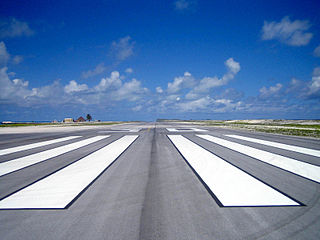
Totegegie Airport is an airport on Totegegie Island in the Gambier Islands, French Polynesia. It is 9 km northeast of the village of Rikitea.

This page list topics related to French Polynesia.

Kamaka is an island in the Gambier Islands of French Polynesia, 11.7 km south of Mangareva within the same lagoon. Kamaka is about one kilometre in length, 700 metres wide, and has an area of 0.5 square kilometres. The highest point is 166 metres above sea level. There are no permanent springs on the island.

Mount Duff, also called Auorotini in the Mangarevan language, is the highest peak on the island of Mangareva in the Gambier Islands, French Polynesia. It has an elevation of 441 m. The peak was named by James Wilson after the ship Duff, which carried missionaries of the London Missionary Society to Tahiti.
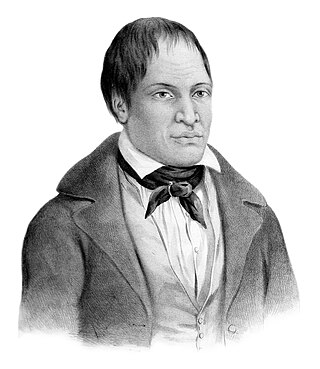
Te Maputeoa was a monarch of the Polynesian island of Mangareva and the other Gambier Islands. He was the King or ʻAkariki, as well as the penultimate king of the island of Mangareva, and other Gambier Islands including Akamaru, Aukena, Taravai and Temoe. He reigned from 1830 until his death in 1857.

Joseph Gregorio II was the last King or ʻAkariki of the island of Mangareva, and other Gambier Islands including Akamaru, Aukena, Taravai and Temoe. His short reign lasted from 1857 until his death in 1868. His childless death left the royal succession of Mangareva in doubt.
Maria Eutokia Toaputeitou was Queen consort of the island of Mangareva, and other Gambier Islands including Akamaru, Aukena, Taravai and Temoe. She served as regent for her son in his minority and for a short period afterward in the interregnum period when the royal succession of Mangareva was in doubt.

Honoré Laval, SS.CC., was a French Catholic priest of the Congregation of the Sacred Hearts of Jesus and Mary, a religious institute of the Roman Catholic Church, who evangelized the Gambier Islands.
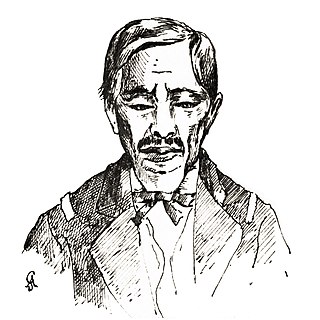
Bernardo Putairi was the Prince Regent of the island of Mangareva, and other Gambier Islands including Akamaru, Aukena, Taravai and Temoe from 1873 to 1881. He served as regent and de facto monarch during the interregnum period when the royal succession of Mangareva was in doubt and after the death of the last royal heir became the last monarch of the island kingdom. His name is often written Putaïri or Putairï in French sources.
Tiripone Mama Taira Putairi, SS.CC., (1846–1881) was educated by French missionaries from birth and became the first indigenous Roman Catholic priest ordained in Eastern Polynesia. He was part of the native royal family of Mangareva, and his father Bernardo Putairi was the island's last ruling regent.
Arone Teikatoara was the penultimate Prince Regent of the island of Mangareva, and other Gambier Islands including Akamaru, Aukena, Taravai and Temoe from 1869 to 1873. He served as regent and de facto monarch during the interregnum period when the royal succession of Mangareva was in doubt. His first name has also been spelled "Arona", "Aarona" or "Aarone".
Akakio Tematereikura was the Prince Regent of the Polynesian island of Mangareva and other territories of the Gambier Islands, including Akamaru, Aukena, Taravai and Temoe, in 1869. He served as regent and de facto monarch during the interregnum period when the royal succession of Mangareva was in doubt. His name is also written as Akakio Matereikura in some French sources.
Undecimal is a positional numeral system that uses eleven as its base. While no known society counts by elevens, two are purported to have done so: the Māori and the Pañgwa. The idea of counting by elevens remains of interest for its relation to a traditional method of tally-counting practiced in Polynesia. During the French Revolution, undecimal was briefly considered as a possible basis for the reformed system of measurement. Undecimal numerals have applications in computer science, technology, and the International Standard Book Number system. They also occasionally feature in works of popular fiction. In undecimal, a capital letter or the digit ↊ is typically used as a transdecimal symbol to represent the number 10.
Karenleigh A. Overmann is a cognitive archaeologist known for her work on how ancient societies became numerate and literate. She currently directs the Center for Cognitive Archaeology at the University of Colorado, Colorado Springs. Before becoming an academic researcher, Overmann served 25 years of active duty in the U.S. Navy.





